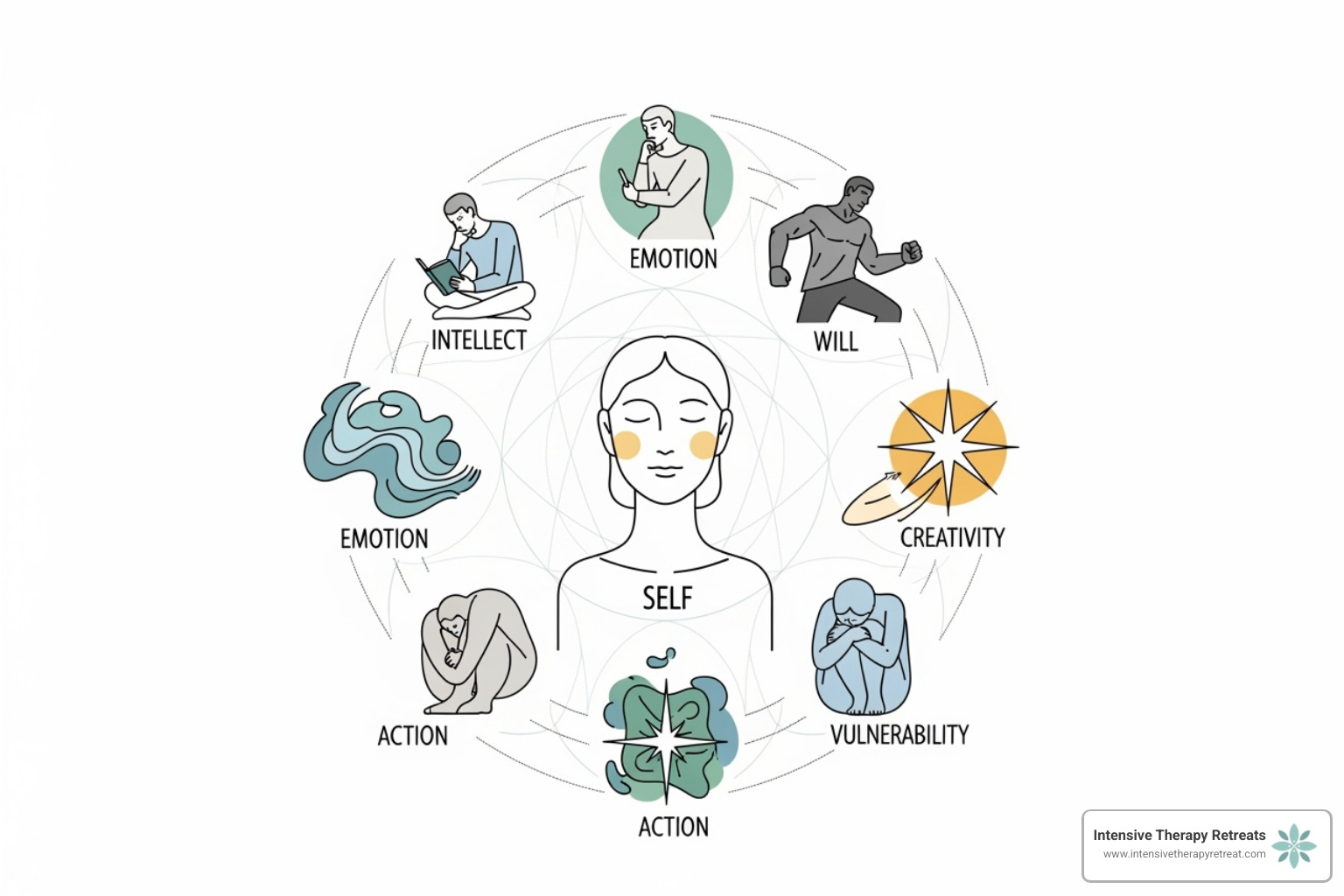Internal Family Systems Therapy PDF: Ultimate 2025
Open uping Your Inner World: An Introduction to Internal Family Systems Therapy
If you’re looking for an internal family systems therapy pdf, you’re likely seeking resources to understand your inner world, such as introductory guides, therapeutic worksheets, or excerpts from foundational texts by IFS founder Richard Schwartz.
What if the idea that we have a single personality is wrong? We all hear conflicting inner voices—one telling us to go for it, another urging don’t you dare. Internal Family Systems (IFS) therapy sees this not as a problem, but as a natural state. It offers a way to understand your mind as being made up of many “parts” and a wise, compassionate core called the “Self.”
IFS, developed by Dr. Richard Schwartz, helps you see that all your inner parts, even challenging ones, have positive intentions. Instead of judging or trying to eliminate them, it guides you to build a harmonious relationship with them, leading to deep, lasting healing.
As Bambi Rattner, Psy.D., my experience in transformative healing methods like EMDR and Progressive Counting informs my approach to IFS. This guide will simplify the core ideas of Internal Family Systems, helping you understand your inner family and how an internal family systems therapy pdf can support your journey.
What is Internal Family Systems (IFS) Therapy?
Internal Family Systems (IFS) therapy, a powerful approach developed by Dr. Richard Schwartz, views the mind as a vibrant community. Instead of a single entity, we are made of many different “parts” and a wise, compassionate core known as the “Self.” From “systems thinking,” IFS understands that all these parts work together. Even parts whose actions seem unhelpful have a positive intention—usually to protect you from pain. This core principle makes IFS a compassionate and effective path to healing, inviting us to approach our inner world with curiosity instead of judgment.
If you’re curious to dive deeper into the foundational principles, you can explore The Internal Family Systems Model Outline. And to learn more about how we integrate this healing approach into our work, take a look at our page on IFS Therapy Explained.
The Shift from a ‘Mono-Mind’ View
Traditional psychology often viewed the mind as a single, unified personality (a “mono-mind”), leading to self-criticism when we experience inner conflict. We might feel frustrated by actions that seem “out of character.” IFS challenges this, suggesting that conflicting inner voices—one urging “Go for it!” while another whispers “Don’t you dare!”—are not signs of being broken. They are normal expressions of our internal multiplicity. This perspective is liberating. Instead of fighting our inner conflicts, IFS invites us to understand them as different “parts,” each with a unique role. By working with these parts, we can move from internal struggle to harmony, a process central to How Does Internal Family Systems Therapy Work?.
The Core Assumption: There Are No Bad Parts
A radical and freeing belief in IFS is that there are no “bad” parts. While some parts may lead to procrastination or lashing out, their underlying intentions are always positive. A part that pushes you to overwork might be protecting you from feelings of inadequacy. An impulsive part might be trying to distract you from deep pain. These are all protective intentions, even if the actions have become extreme. The goal of IFS isn’t to eliminate these parts but to help them transform. We seek to understand why they adopted extreme roles—often due to past trauma or attachment injuries. By acknowledging their protective intent and addressing the pain they carry, we help these parts heal and relax. This compassionate approach is highly effective, especially in IFS for Trauma, where we liberate parts from past burdens.
The Core Components of Your Inner World: The Self and Its Parts
At the heart of the IFS model is the relationship between the “Self” and our various “parts.” Think of your internal system as a family, where the “Self” is the compassionate, wise leader, and the “parts” are the family members, each playing a unique role. This understanding allows us to approach our inner world with curiosity and respect, fostering internal harmony and self-leadership.
This concept of internal family dynamics and self-leadership is a cornerstone of The Practice of Internal Family Systems (IFS).
The Three Types of Protective Parts
Within our internal family, IFS identifies three main types of parts, categorized by their primary functions: Managers, Firefighters, and Exiles. While their roles differ, they all ultimately aim to protect us.
-
Managers: These proactive parts try to keep us safe by controlling our environment and emotions to prevent vulnerability. They are responsible for our daily functioning, perfectionism, and inner criticism. They are the system’s planners, constantly trying to prevent potential dangers.
-
Firefighters: These reactive parts activate when an Exile is triggered, aiming to “put out the fire” of emotional pain. They use impulsive behaviors like binging on food, work, or substances, and sometimes more drastic measures like rage or self-harm. Their goal is to numb or distract from pain, acting as the system’s emergency responders.
-
Exiles: These are vulnerable parts holding pain, memories, and negative beliefs from past trauma or attachment injuries. Managers and Firefighters work to keep them “exiled” to prevent their overwhelming pain from flooding the system. Exiles carry burdens like shame and fear and are often stuck in the past. Healing in IFS involves the Self gently approaching and unburdening these Exiles, allowing them to release their pain and reclaim their positive qualities.
Understanding these different protective roles is key to navigating our inner world. You can learn more about these fascinating aspects of our inner landscape at Sub-Types of Internal Family Systems Model.
The Healing Power of the Self
While parts are the players, the “Self” is the wise, compassionate leader of our inner family. The Self is not a part; it’s our essential core—inherently good, whole, and undamaged. It’s the calm center that can guide our internal system, though it can sometimes be obscured when “blended” with parts. When we are “Self-led,” we operate from a place of wisdom and courage.
The core qualities of the Self are often referred to as the “8 Cs”:
- Curiosity: An open, non-judgmental interest in our internal experiences.
- Calm: A sense of inner peace and composure, even amidst chaos.
- Confidence: A belief in our innate ability to handle challenges.
- Compassion: A deep sense of empathy and kindness towards ourselves and others.
- Creativity: The ability to find new solutions and perspectives.
- Clarity: The capacity to see situations clearly, without distortion from parts.
- Courage: The willingness to face difficult emotions and situations.
- Connectedness: A feeling of belonging and connection to ourselves, others, and the world.
These 8 Cs are universally present within us. The goal of IFS therapy is to help us access this Self-energy and allow it to lead our internal system, fostering healing and harmony. To explore this further, you can find a helpful resource in the What the Self Is and Isn’t in IFS Therapy worksheet.
The Goals and Healing Process in IFS
So, what’s the big picture goal of IFS therapy? It’s all about bringing internal harmony to your inner world and gently guiding your wise Self back into its natural leadership role. This doesn’t just improve how you feel inside; it also transforms your relationships with others. When you move from inner battles to a state of peace, that positive energy naturally ripples outward.
This journey towards inner peace and balance has a truly Positive Impact of Internal Family Systems Therapy (IFS) on your entire life.
How Parts Become Burdened and How to Liberate Them
Parts become “burdened” when forced to carry heavy loads from painful experiences like trauma, attachment injuries, or “Legacy Burdens” (beliefs passed down through family or culture). These burdens are not the part’s true nature; they are like heavy backpacks filled with intense emotions and memories. The transformative process of unburdening in IFS helps parts set down these packs.
Here’s how the compassionate journey unfolds: First, you learn to access your Self-energy—your calm, curious core. From this Self-led place, you approach your Manager and Firefighter parts, befriending them and acknowledging their protective intentions. This helps them trust your Self to lead, allowing them to relax. Once protectors feel safe, your Self can compassionately witness the Exile, connecting with the vulnerable part that holds the pain. You listen to its story and offer comfort, acting as a loving witness. Finally, the exiled part is invited to release its burdens—the shame, fear, or worthlessness it has carried. As the part unburdens, it reclaims its positive, essential qualities, like playfulness or spontaneity, which were hidden beneath the pain.
This beautiful process allows us to bring Exiles out of the past and into the present, where they can finally release their burdens and refind their innate goodness. It’s a powerful way of Utilizing IFS Core Principles for Trauma Healing.
The Primary Goals of IFS Therapy
IFS therapy has clear, heartwarming goals that guide your healing journey:
- Liberating parts from their extreme roles: This means helping hardworking Managers and impulsive Firefighters relax, and allowing Exiles to release their painful burdens. The aim is to help parts transform back to their healthy, joyful expression.
- Restoring trust in Self-leadership: As parts unburden, your wise Self naturally emerges as the internal leader, building your confidence in its ability to guide your inner system.
- Re-harmonizing the inner system: With the Self in leadership and parts feeling safe, your internal family functions as a team. Inner conflicts fade, and parts return to their positive roles.
- Fostering Self-led interaction with the world: As inner harmony grows, you can steer life’s challenges with clarity, compassion, and courage, rather than reacting from fear-based parts.
By achieving these goals, IFS empowers you to experience profound inner peace and build more fulfilling relationships. This approach is incredibly beneficial for conditions like depression, where internal conflicts can feel overwhelming. Find more about this at Overcoming Depression with IFS Therapy.
Practical IFS Techniques and Free Internal Family Systems Therapy PDF Resources
One of the great things about IFS is its practicality. It provides tangible techniques and exercises to explore your inner world, whether with a therapist or on your own. Many of these tools are available as an internal family systems therapy pdf, making them easy to access. These interventions are designed to help you connect with your inner parts, understand their purpose, and guide them toward healing.
If you’re curious about how these methods are put into practice, you can get a comprehensive overview by visiting our page on Internal Family Systems Interventions.
Common Exercises to Connect With Your Parts
Connecting with your internal parts is made accessible through structured IFS exercises.
One powerful technique is The Six Fs. This helps you differentiate protective parts. The steps guide you to Find a part, Focus on it, Flesh Out your understanding of it, Feel how you feel towards it (to access Self), Befriend it with curiosity, and finally, ask about its Fears. This systematic approach builds trust with protectors. You can find a helpful guide for this in The Six Fs worksheet.
Another foundational practice is the All Parts Are Welcome exercise. This simple yet profound exercise encourages you to welcome all thoughts, feelings, and sensations without judgment, creating a safe space for your parts to feel seen. You can find this valuable exercise in an All Parts Are Welcome exercise PDF.
When reactive Firefighter parts kick in, the Fire Drill exercise can be a game-changer. This reflective exercise helps you understand why they reacted. You recall a moment of overwhelm, reflect on which part took over, what it was protecting, and what it feared. This fosters compassionate understanding instead of self-criticism.
Your Free Internal Family Systems Therapy PDF Toolkit
Many wonderful resources are available as an internal family systems therapy pdf to help you explore your inner world at your own pace.
Here are a few worksheets to get you started:
- The Understanding Our Relationship With a Part worksheet helps you dive deep into a specific part’s role, intention, and fears.
- The Identifying Parts of Yourself Through Drawing worksheet is a creative way to connect with parts and uncover surprising insights.
- The Identifying Managers and Firefighters worksheet helps you notice your protectors’ strategies in daily life, giving you more choice in how you respond.
For even more resources, explore our full collection of Internal Family Systems Therapy Worksheets.
Benefits of Engaging with an Internal Family Systems Therapy PDF or Therapist
Whether you explore IFS through a PDF or with a therapist, the benefits can be profound. Research shows IFS is effective for a wide range of mental health challenges.
People who engage with IFS often experience:
- Reduced anxiety and depression: As parts heal and protectors relax, your internal system calms, significantly reducing these feelings.
- Improved self-compassion: The core idea of “no bad parts” helps you replace self-criticism with genuine understanding.
- Better emotional regulation: As your Self leads, you can manage intense emotions thoughtfully rather than reacting impulsively.
- More fulfilling relationships: Inner harmony leads to more authentic and compassionate relationships with others.
- Healing complex PTSD and trauma: IFS is powerful for trauma recovery, as it directly addresses exiled parts holding traumatic memories and helps protectors relax.
IFS empowers you to become your own inner leader, fostering lasting wholeness and peace. To learn more about how IFS can help, visit our page on Mental Health Conditions IFS Can Help With.
Conclusion
Internal Family Systems (IFS) therapy offers a compassionate and empowering path to understanding your inner world. We’ve explored how your mind is a chorus of “parts”—protective Managers and Firefighters, and vulnerable Exiles—all guided by the wise, loving core of the Self. The goal is to shift from self-criticism to inner harmony by tapping into the Self’s 8 Cs: Curiosity, Calm, Confidence, Compassion, Creativity, Clarity, Courage, and Connectedness.
The magic of IFS lies in its ability to help you liberate parts from the heavy burdens they’ve carried. It’s about restoring your innate Self-leadership as a lifelong skill. This process can lead to incredible benefits: reduced anxiety, greater self-compassion, more authentic relationships, and deep, lasting healing from trauma.
At Intensive Therapy Retreats, we believe in the power of immersive healing for fast, lasting results. Our unique approach integrates IFS with other proven methods like EMDR and ART to help you achieve significant healing in days, not years. Imagine the profound shifts possible when you dedicate focused time to your well-being in a supportive, expert-guided environment.
If you’re ready to dive deep and open up your innate capacity for healing and Self-leadership, we invite you to experience the transformative power of IFS. Ready to start a journey of self-findy and lasting healing? Explore our IFS Therapy Retreats and learn how we can help you integrate your internal family for a more peaceful, confident, and fulfilling life.


